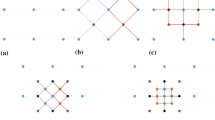Abstract
Multiple-point statistics simulation has recently attracted significant attention for the simulation of complex geological structures. In this paper, a fast direct sampling (FDS) algorithm is presented based on a fast gradient descent pattern matching strategy. The match is directly extracted from the training image (TI) and so the method does not require intensive preprocessing and database storage. The initial node of the search path is selected randomly but the following nodes are selected in a principled manner so that the path is conducted to the right match. Each node is selected based on the matching accuracy and the behavior of the TI in the previous node. A simple initialization strategy is presented in this paper which significantly accelerates the matching process at the expense of a very naïve preprocessing stage. The proposed simulation algorithm has several outstanding advantages: it needs no (or very limited) preprocessing, does not need any database storage, searches for the match directly in the TI, is not limited to fixed size patterns (the pattern size can be easily changed during simulation), is capable of handling both continuous and categorical data, is capable of handling multivariate data, and finally and more importantly, is a fast method while maintaining high standards for the matching quality. Experiments on different TIs reveal that the simulation results of FDS and DS are comparable in terms of pattern reproduction and connectivity while FDS is far faster than DS.







Similar content being viewed by others
References
Aitokhuehi I, Durlofsky LJ (2005) Optimizing the performance of smart wells in complex reservoirs using continuously updated geological models. J Petrol Sci Eng 48(3–4):254–264
Arpat BG, Caers J (2007) Stochastic simulation with patterns. Math Geol 39(202):177–203
Caers J, Strebelle S, Payrazyan K (2003) Stochastic integration of seismic data and geologic scenarios: a West Africa submarine channel saga. Lead Edge 22(3):192–196
Chugunova T, Hu L (2008) Multiple–point simulations constrained by continuous auxiliary data. Math Geosci 40(2):133–146
Feyen L, Caers J (2006) Quantifying geological uncertainty for flow and transport modeling in multimodal heterogeneous formations. Adv Water Resour 29(6):912–929
Gloaguen E, Dimitrakopoulos R (2009) Two-dimensional conditional simulations based on the wavelet decomposition of training images. Math Geosci 41(6):679–701
Gonzalez RC, Woods RE (2008) Digital image processing, 3rd edn. Prentice Hall, Upper Saddle River
Guardiano F, Srivastava M (1993) Multivariate geostatistics: beyond bivariate moments. In: Geostatistics—Troia. Kluwer Academic, Dordrecht, pp 133–144
Hoffman BT, Caers J (2007) History matching by jointly perturbing local facies proportions and their spatial distribution: application to a North Sea reservoir. J Petrol Sci Eng 57(3–4):257–272
Honarkhah M, Caers J (2010) Stochastic simulation of patterns using distance-based pattern modeling. Math Geosci 42:487–517
Hu L, Chugunova T (2008) Multiple–point geostatistics for modeling subsurface heterogeneity: a comprehensive review. Water Resour Res 44:W11413. doi:10.1029/2008WR006993
Huysmans M, Dassargues A (2009) Application of multiple–point geostatistics on modeling groundwater flow and transport in a crossbedded aquifer (Belgium). Hydrogeol J 17:1901–1911
Isaaks E (1990) The application of Monte Carlo methods to the analysis of spatially correlated data. Ph.D. thesis, Stanford University
Journel AG (1983) Non-parametric estimation of spatial distributions. Math Geol 15(3):445–468
Kjønsberg H, Kolbjørnsen O (2008) Markov mesh simulations with data conditioning through indicator kriging. In: Proceedings of the 8th International Geostatistics Congress, Santiago, Chile
Larriestra C, Gomez H (2009a) Multiple-point simulation applied to uncertainty analysis of reservoirs related to high sinuosity fluvial systems: Mina el Carmen formation, San Jorge gulf basin, Argentina. IAMG Annual Meeting, Stanford University, USA
Larriestra C, Gomez H (2009b) Uncertainty Analysis of Reservoirs from Meandering Fluvial Systems using Multiple Point Stochastic Simulation. Mina El Carmen Formation, San Jorge Gulf Basin, Argentina. AAPG Annual Meeting, Río de Janeiro, Brazil
Liu Y, Harding A, Abriel W, Strebelle S (2004) Multiple–point simulation integrating wells, three–dimensional seismic data, and geology. AAPG Bull 88(7):905–921
Lyster S, Deutsch CV (2008) MPS simulation in a Gibbs sampler algorithm. In: Proceedings of the 8th International Geostatistics Congress, Santiago, Chile
Mariethoz G, Renard P, Straubhaar J (2010) The direct sampling method to perform multiple-points geostatistical simulations. Water Resour Res. doi:10.1029/2008WR007621
Remy N, Boucher A, Wu J (2009) Applied geostatistics with SGeMS: a user’s guide. Cambridge University Press, Cambridge
Renard P (2007) Stochastic hydrogeology: what professionals really need? Ground Water 45(5):531–541
Strebelle S (2002) Conditional simulation of complex geological structures using multiple point statistics. Math Geol 34(1):1–22
Strebelle S, Payrazyan K, Caers J (2003) Modeling of a deepwater turbidite reservoir conditional to seismic data using principal component analysis and multiple–point geostatistics. SPE J 8(3):227–235
Szeliski R (2010) Computer vision: algorithms and applications. Springer, Heidelberg
Tahmasebi P, Hezarkhani A, Sahimi M (2012) Multiple-point geostatistical modeling based on the cross correlation functions. Comput Geosci 16(3):779–797
Tjelmeland H (1996) Stochastic models in reservoir characterization and Markov random fields for compact objects. Doctoral dissertation, Norwegian University of Science and Technology, Trondheim
Tjelmeland H, Eidsvik J (2004) Directional Metropolis–Hastings updates for posteriors with non linear likelihood. In: Leuangthong O, Deutsch CV (eds) Geostatistics. Springer, Banff, pp 95–104
Umazano M, Larriestra C, Bellosi E (2009) Multiple-point simulation of channelized and unconfined fluvial deposits: an exploratory model for Cretaceous oil-bearing sandstones of central Patagonia. 9th International Conference on Fluvial Sedimentology San Miguel de Tucuman—Tucuman, Argentina
Wu J, Zhang T, Journel AG (2008) A fast FILTERSIM simulation with score-based distance. Math Geosci 47:773–788
Zhang T, Switzer P, Journel AG (2006) Filter-based classification of training image patterns for spatial simulation. Math Geol 38:63–80
Author information
Authors and Affiliations
Corresponding author
Rights and permissions
About this article
Cite this article
Abdollahifard, M.J., Faez, K. Fast direct sampling for multiple-point stochastic simulation. Arab J Geosci 7, 1927–1939 (2014). https://doi.org/10.1007/s12517-013-0850-4
Received:
Accepted:
Published:
Issue Date:
DOI: https://doi.org/10.1007/s12517-013-0850-4




